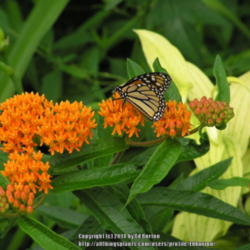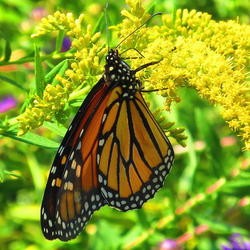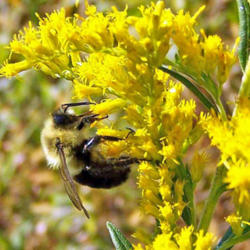Native plants possess tremendous value for the backyard gardener. They add beauty, provide important habitat and food for native pollinators and other wildlife, help to preserve our natural heritage, require little maintenance once established, and serve to control soil erosion through well-adapted root systems. Current estimates indicate that, of the 20,000 plant species native to North America, almost 25 percent are at risk of becoming extinct. In this article, I will focus on two native species you might want to help preserve by planting them in your own garden: Milkweeds and Solidagos.
Milkweed (Asclepias spp)
There are over 140 known species of Milkweed, most of them native to North America. Like many native plant species, Milkweed serves a vital role in local ecosystems. Asclepias species are the host plants for at least 40 different butterfly and moth species around the world, with about 25 of these in North America. Of these, the Monarch butterfly is arguably the best known and best loved.
Monarchs are not only beautiful and iconic among American butterflies, but they are also migratory, each year flying 3,000 miles over four generations from far northern breeding sites to forests where they overwinter in Mexico. Unfortunately, the Monarch population has declined by nearly 90% over the past 20 years. Part of this decline is attributable to habitat loss in their Mexican wintering grounds, and some is due to extreme weather over the past few years. However, a major contributor is habitat loss in the U.S., particularly the massive declines (58-90%) of Milkweed in Midwestern farming regions. Monarch caterpillars feed exclusively on Milkweed species. In days past, stands of Asclepias syriaca or Common Milkweed were abundant along the edges of crop fields, but the introduction of herbicide-resistant crops has meant the demise of much of this Milkweed, with devastating results for the Monarch. For example, Xerces notes that a 58% decline in Milkweed density in the Midwest corresponded to an 81% decline in Monarchs between 1999 and 2010.
Monarch caterpillars on Milkweed
To address the issue of habitat loss in the U.S., several programs (e.g., Monarch Waystation, Bring Back the Monarchs, Milkweed Market) have been launched with the goal of raising awareness and restoring habitat through the planting of Milkweed. In addition, a petition has been filed to protect the Monarch by declaring it a threatened species through the Endangered Species Act. For all of us, planting locally available Milkweed species in our yards will help in the habitat restoration efforts. To find Milkweed species and seed vendors for your area, search Xerces’ Milkweed Seed Finder site.
http://www.xerces.org/milkweed...
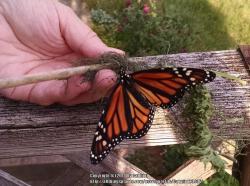
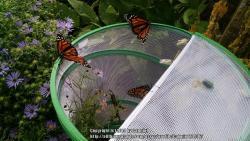
Monarch butterflies hand-raised from eggs found on Tropical Milkweed planted in my garden
Goldenrod (Solidago spp)
Milkweed is necessary as a host plant for Monarch caterpillars, but once the butterfly has emerged, it needs plants to nectar on. One important Monarch nectar plant is Goldenrod or Solidago, which blooms golden yellow in the fall at the time of the Monarch migration to Mexico. Comprised of between 100 and 120 species, most of them native to North America, Goldenrod is widespread throughout the United States. Contrary to popular belief, its sticky pollen is not easily windborne, and it is not to blame for the fall hayfever so many suffer from.
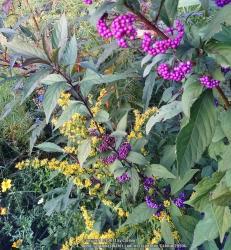
Solidago caesia with Beauty Berry.
Goldenrod leaves are edible, and have been used in traditional herbal medicine for a variety of ailments, including sore throats and kidney stones. Three states identify Goldenrod as their state flower or wildflower (Kentucky, Nebraska, and South Carolina), and one (Delaware) as its state herb. In the western U.S., Solidago californica serves as a larval host for two butterfly species: the Northern Checkerspot and the Field Crescent. Clearly, Goldenrod species are widespread in the U.S., and as such they play an important role in native ecosystems, attracting a variety of pollinators and other beneficial insects in addition to the Monarch butterfly.
As mentioned, Goldenrod’s early fall bloom time corresponds with the Monarch migration, and Solidago species are a Monarch Waystation certification plant. Please visit the Monarch Waystation site for information on creating Monarch-friendly space in your yard or garden:
http://www.monarchwatch.org/wa...
